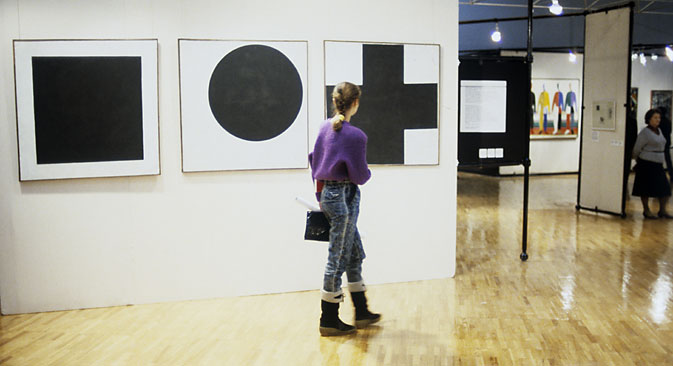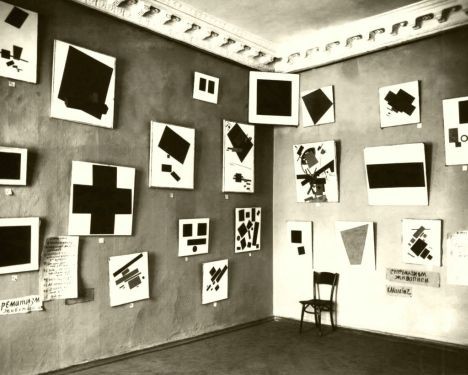Supreme talent: Malevich’s ‘Black Square’ marks 100 years

The original Black Square (1915) today hangs in the Tretyakov Gallery in Moscow on Krymsky Val
Yuriy Somov/RIA NovostiJust under 100 years ago, visitors to an exhibition of Futurist art in Petrograd (as St. Petersburg was then known) were surprised by a painting the like of which they had never seen before. The canvas, painted by
The exhibition, named "The Last Futurist Exhibition 0.10." marked the first occasion that the public had been able to see the works Malevich had executed according to the principles of the Suprematist movement that he had invented, in which art was reduced to pure geometric forms that lent themselves to universal comprehension.
The painter's associates, as well as the public, were

The painting, which was first put on public display back in December 1915, has been an avant-garde icon ever since its creation
Open sourcesAlthough the exhibition was held in December 1915, the 100th birthday of Black Square is being celebrated not in the winter but in the summer. Russian art scholar and Malevich expert Alexandra Shatskikh
In the
The return of Black Square
But nevertheless, Malevich was eventually to acquire world fame, albeit posthumously. However, this was not to happen until after World War Two, when a new boom of abstract art took off in Europe and the U.S. However, some of his Suprematist works could be found in New York's Museum of Modern Art even before the war and several paintings had found their home in private European collections.
However,
Malevich had brought the collection to Berlin in 1927 as a personal exhibition and when he suddenly had to return home, he left the works with German architect Hugo Häring. The painter was never able to get the paintings back. Subsequently, Häring managed to conceal this artistic archive from the Nazi authorities, preserve it during the war and in the end send it to the Dutch museum. When the works were exhibited and reproduced in photo albums, they had an unimaginable effect on those who saw them. Even more incredible is that the lion's share of Malevich's legacy remained inaccessible to the western public until the advent of perestroika in the USSR in the 1980s.
St. Petersburg art historian and Russian avant-garde expert Irina Karasik believes that Malevich’s masterpiece ranks alongside the most influential artworks in history. "In the history of world art perhaps there is no painting that has had more fame than Malevich's Black Square, there is no work that has brought about so many other works," she said. The painting's influence is very diverse, even unexpected. Paradoxically, in
Admirers and followers of Black Square
Black Square, which the artist characterized as a "lively, regal youth," was supposed to produce an effect not
While we can say that artists such as the 50s-60s American minimalists Carl Andre and Donald Judd borrowed much from Suprematist principles, the French action painter Yves Klein and American Mark Rothko have nothing in common with Malevich's airy geometry. Nevertheless, the latter two painters often talked about Russian abstractionism as a major reference point.
The Suprematists' declaratory refusal of "graphic frills" can be considered a prologue for conceptualism.
The apotheosis of Black Square's influence on designers and architects came 10 years after WWII. Many of them, thanks to Suprematism, understood geometry not as a formal professional technique but as a philosophy of space. In one way or another this philosophy can be felt in the works of Brazilian architect Oscar Niemeyer, American architect Daniel Libeskind, Italian architect Renzo Piano (who built the New York Times Building), French designer Philippe Starck and American industrial designer Karim Rashid.
Another internationally acclaimed architect, Zaha Hadid, has often confessed publically her passion for Malevich's art. In particular, she once wrote in the British Royal Academy of Arts Magazine: "I had found the traditional system of architectural drawing exhausted. Studying Malevich helped me transform abstraction into an investigative principle." It is not by chance that in her personal exhibition, which recently opened at the State Hermitage Museum in St. Petersburg, one of the versions of the famous BlackSquare is seen as an epigraph.
The original Black Square today hangs in the Tretyakov Gallery in Moscow on Krymsky Val. Copies of the painting, which Malevich executed in the 1920s, can be found in the Russian Museum, in the Hermitage and two in the Tretyakov Gallery's storerooms.
All rights reserved by Rossiyskaya Gazeta.
Subscribe
to our newsletter!
Get the week's best stories straight to your inbox